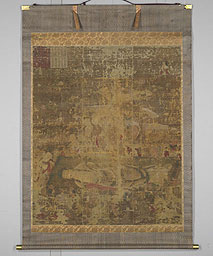The Nirvana of Buddha, Late Heian Period@Important Cultural Property
@Color on silk 164.8cm~137.6cm
@Perhaps due to its continuous use after many years, the painting is considerably damaged. The names of bodhisattvas and disciples of the Buddha are inscribed directly on the painting and is thus of great importance for research.
@The kirigane (cut gold foil) pattern and gold and silver ornament make this a particularly gorgeous painting. As a result of the latest infrared photography, two disciples of the Buddha who were heretofore invisible have been discovered. None of the animals that are usually depicted in similar paintings are found here.
@Beginning with Maya Bunin, the mother of ??kyamuni Buddha, in the upper right, the names of 12 different figures can be identified. The design and placement of the figures in the painting closely resemble those of National Treasure Nehan-zu at Kongobuji on Koyasan, which is inscribed with date Otoku 3 (1086), thus this painting is also representative of Heian-era style.
@Given these factors, Jizo bosastsu (Sk. Ksitigarbha) and other figures can be identified through comparison with the other painting even though the names have been abraded and are now lost from this example.
@The notation below Maya Bunin reads the explanatory "Batsudaiga," the Japanese name for the river near which the Buddha entered nirvana. At the upper left is a cartouche-like shikishigata with words describing the Buddha's nirvana.
